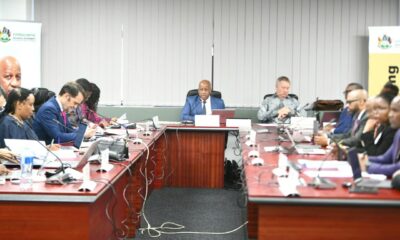News
Gauteng Forks Out R5.4 Billion in Final E-Toll Payment Amid Service Delivery Strain

Province meets its debt obligation, but MEC says it’s costing schools, hospitals and pothole repairs
The Gauteng Provincial Government has paid R5.44 billion towards settling its controversial e-toll debt, closing one of the most politically fraught chapters in the province’s infrastructure history, but not without consequences for service delivery.
Finance MEC Lebogang Maile confirmed on Sunday that the final transfer to National Treasury would go through on Monday, marking the second instalment in Gauteng’s agreed 30% share of the R15.9 billion owed for the now-defunct Gauteng Freeway Improvement Project (GFIP).
The e-toll gantries, once the subject of mass resistance campaigns and citizen non-compliance, were finally switched off in April 2024, a full decade after tolling was implemented. Treasury agreed to cover 70% of the debt, leaving Gauteng with a significant financial burden in an already tight fiscal environment.
Debt Settled, But at What Cost?
“This is money we could have used to build new schools or hospitals,” said Maile at a briefing on Sunday. “If we weren’t paying this R5.4 billion, we could’ve been fixing all potholes in the province or upgrading traffic lights.”
The latest R5.4 billion payment includes a R3.38 billion portion towards historical debt and R2.09 billion for the urgent rehabilitation of major highways like the N1, N3, N14, and R21. Maile stressed that these payments are non-negotiable under the signed Memorandum of Agreement (MoA) with SANRAL and National Treasury.
The previous instalment of R3.8 billion was paid in September 2024, meaning Gauteng’s total contributions towards the e-toll bill now stand at over R9 billion.
[WATCH] Gauteng MEC for Finance Lebogang Maile says an amount of R5.76 billion will be paid tomorrow for the e-toll debt and towards SANRAL freeway upgrades. pic.twitter.com/NC8AmyC64T
— Newzroom Afrika (@Newzroom405) June 29, 2025
Where Will the Money Go?
Maile confirmed that the funds paid to SANRAL are ringfenced and can only be used for nine key road upgrade projects. These include stretches such as 14th Avenue to Buccleuch, Brakfontein to Scientia, and Geldenhuys to Buccleuch, some of Gauteng’s busiest and most congested routes.
“These freeways are the economic arteries of the Gauteng City Region,” Maile said. “They support everything from freight logistics to daily commuter traffic.”
But even with this much-needed investment in transport infrastructure, the cost of honouring the e-toll agreement has come with painful trade-offs.
Service Delivery Under Pressure
“We’ve had to make tough choices,” Maile admitted. “The repayment does have an impact on service delivery because it means we have limited resources.”
He said the province is already implementing strict cost-cutting measures and launching a new Revenue Enhancement Strategy to help rebuild provincial finances. This includes plugging leakages in supply chain management, exploring new revenue streams, and optimising existing tax collection systems.
Still, critics argue that the R5.4 billion could have been better spent on pressing local needs, especially as communities across Gauteng continue to grapple with crumbling infrastructure, hospital backlogs, and understaffed schools.
A Controversial Legacy
The e-toll system has long been a thorn in the side of Gauteng residents and politicians alike. Widely boycotted and politically toxic, it became a rallying point for opposition parties and civil society movements.
While the gantries have now gone dark, the financial fallout will echo for years to come.
Gauteng’s final instalment may bring the saga to a close, but as Maile put it, “We are still paying for decisions made long ago and the people of Gauteng are the ones carrying the cost.”
{Source: The Citizen}
Follow Joburg ETC on Facebook, Twitter , TikTok and Instagram
For more News in Johannesburg, visit joburgetc.com



























